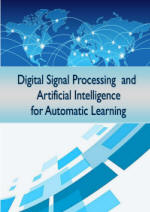| Research project: Detection of Cardiac Arrhythmia Patterns by Adaptive Analysis |
| << TO BE UPDATED, PLEASE VISIT AGAIN>> |
| Th adaptive technology makes use of a neural models with error back-propagation and explores the gradient-decent method for sample-by-sample adaptation. The implementations of the higher-order neural models have been developed in Python language. |
| There are several types of adaptive methodologies, such as multilayer neural networks, higher-order neural networks, adaptive self-organized maps, and adaptive radial basis function neural networks, among others. |
| Pattern recognition is one of the beneficial fields when we consider the development of adaptive methodologies, because of its multiple applications in several knowledge areas. Development of new mathematical models stimulates the research community to creating the new technologies for recognizing behavioral patterns in chaotic systems applied to diagnosing various types of diseases such as: Parkinson’s, cancer, lung and heart disease, to name a few [1]. |
| In several cases it is necessary to use vision systems, since the components that are analyzed can present defects which are not visible to the human eye; so it is necessary to implement technologies to improve processes and subprocesses, such as the inspection and classification of parts, which contain some damage or a specific characteristic, for example, such as a small scratch [2]. |
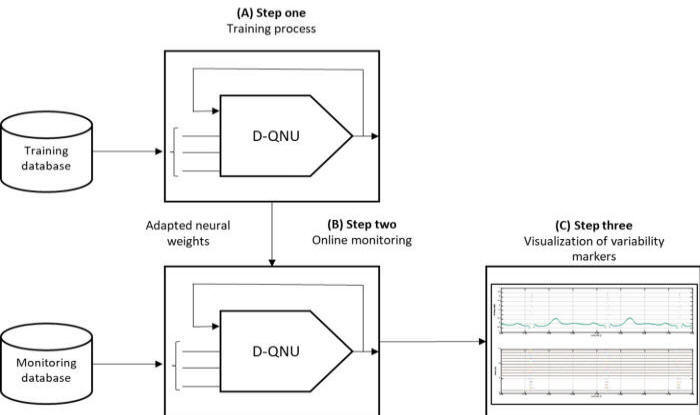 |
| Variability markers visualization of D-QNU [11] |
|
The
adaptive threshold
technique is one of the more
significant part of the detection method. The
adaptive threshold
is performed by using a
pair of threshold limits
called the upper
limited threshold
and the lower
limited threshold.
The adaptive threshold is generally determined based on an amount of most recent data. This work uses a pair of thresholds (upper and lower thresholds), which are initialized in regard to the maximum value attained by the current frame. |
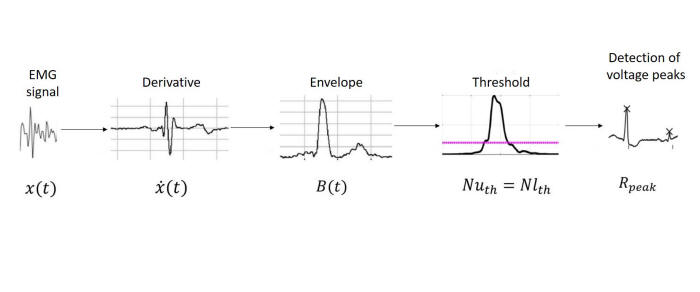 |
| Block diagram of the EMG signal analysis process [17] |
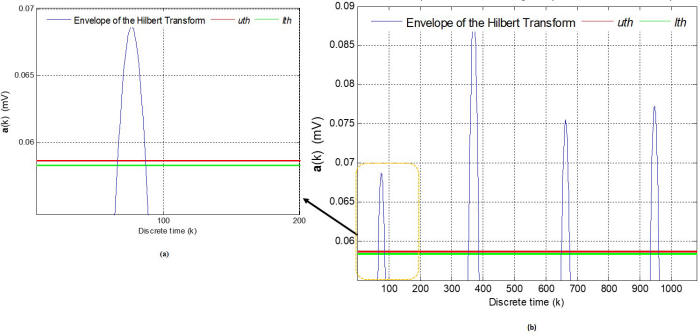 |
| The red line stands for the upper limited threshold, and the green line stands for the lower limited threshold [3]. |
| Publications: |
| Research papers: |
| [1] Ibarra Fierro, Gabriela I.; Rodriguez-Jorge, Ricardo; Mizera-Pietraszko, Jolanta; Martínez García, Edgar Alonso, "Design and implementation of a data acquisition system for R peak detection in electrocardiogram", Artificial Intelligence for Health 2018 (AI4Health 2018), January 19-21, 2018, Funchal, Madeira, Portugal. |
| [2] Mexicano, Adriana; Rodriguez Jorge, Ricardo, et al. "Acceleration of the K-Means algorithm by removing stable items", Int. J. of Space-Based and Situated Computing (IJSSC), Vol. 7, No. 2, 2017 . |
| [3] Rodriguez Jorge, R., García, E. M., Córdoba, R. T., Bila, J., & Mizera-Pietraszko, J. (2017). Adaptive Threshold, Wavelet and Hilbert Transform for QRS Detection in Electrocardiogram Signals (pp. 777–786). https://doi.org/10.1007/978-3-319-69835-9_73 |
| [4] CCarrasco, José Eduardo Carballo, Manuel Nandayapa, Ángel Flores Abad, Ángel Israel Soto Marrufo, and Ricardo Rodríguez Jorge. "Sistema Virtual para control de movimiento basado en LabVIEW-Solidworks." (In Spanish). CULCyT 58 (2016). |
| [5] Medrano, Gerardo Durán, Manuel Nandayapa, Luis Raúl Robles Ramos, Ulises I. Ponce, Ricardo Rodríguez Jorge, and Luis Ricardo Vidal Portilla. "Diseño de un PLC Basado en Microcontrolador para Secuencias Programables Bajo Lenguaje Basic." (In Spanish). CULCyT 58 (2016). |
| [6] Mizera-Pietraszko, Jolanta; Kołaczek, Grzegorz; Rodriguez Jorge, Ricardo, Source-Target Mapping Model of Streaming Data Flow for Machine Translation, 2017, Poland. |
| [7] Rodriguez Jorge, Ricardo, Artificial Neural Networks: Challenges in Science and Engineering Applications, Proceedings of 8th International Conference on Applications of Digital Information and Web Technologies 2017, Ciudad Juarez, Chihuahua, Mexico. |
| [8] Montes Olguín, Angel; Rodriguez Jorge, Ricardo, Climate fuzzy control proposal for a homemade greenhouse, Proceedings of 8th International Conference on Applications of Digital Information and Web Technologies 2017, Ciudad Juarez, Chihuahua, Mexico. |
| [9] Martinez, Ana; Rodriguez Jorge, Ricardo; Villa-Angulo, Rafael; Bila, Jiri; Mizera-Pietraszko, Jolanta, Review on higher-order neural units for monitoring cardiac arrhythmia patterns, Proceedings of 8th International Conference on Applications of Digital Information and Web Technologies 2017, Ciudad Juarez, Chihuahua, Mexico. |
| [10] Rodriguez Jorge, Ricardo; Bila, Jiri; Mizera-Pietraszko, Jolanta; Loya Orduño, Ricardo Ezequiel, "Adaptive Methodology for Designing a Predictive Model of Cardiac Arrhythmia Symptoms based on Cubic Neural Unit," Proceedings of 8th International Conference on Applications of Digital Information and Web Technologies 2017, Ciudad Juarez, Chihuahua, Mexico |
| [11] Cancino Herrera, José Elías; Rodríguez Jorge, Ricardo; Vergara Villegas, Osslan Osiris; Cruz Sánchez, Vianey Guadalupe; Bila, Jiri; Nandayapa Alfaro, Manuel de Jesus; Ponce, Israel U.; Soto Marrufo, Ángel Israel, "Monitoring of Cardiac Arrhythmia Patterns by Adaptive Analysis," 2016 11th International Conference on P2P, Parallel, Grid, Cloud and Internet Computing (3PGCIC), November 2016, Asan, Korea. |
| [12] Cancino Herrera, José Elías; Rodríguez Jorge, Ricardo; Vergara Villegas, Osslan Osiris; Cruz Sánchez, Vianey Guadalupe; Soto Marrufo, Angel Israel; Nandayapa Alfaro, Manuel de Jesus; Ponce, Israel U., "Monitoreo de Patrones de Arritmias Cardiacas Mediante Análisis Adaptativo (In Spanish)," 4to. Encuentro de Jóvenes Investigadores en el Estado de Chihuahua 2016, September 2016, Ciudad Juárez, México. |
| [13] Ponce, Israel U. ;Nandayapa Alfaro, Manuel de Jesús; Soto Marrufo, Ángel Israel; Rodriguez Jorge, Ricardo, "Seguimiento de trayectoria de un helicóptero de 3-GDL con zona muerta y dinámica de primer orden en la entrada (In Spanish)," Congreso Nacional de Control Automático 2016, September 2016, Querétaro, México. |
| [14] Osslan Osiris Viergara Villegas, Vianey Guadalupe Cruz Sánchez, Humberto de Jesús Ochoa Domínguez, Jorge Luis García-Alcaraz, Ricardo Rodriguez Jorge (2016), "Automatic Defect Detection and Classification of Terminals in a Bussed Electrical Center Using Computer Vision", Handbook of Research on Managerial Strategies for Achieving Optimal Performance in Industrial Processes, IGI Publishing Hershey, PA, USA ©2016, May 2016, pp. 241-266, DOI: 10.4018/978-1-5225-0130-5, ISBN13: 9781522501305. |
| [15] Mexicano, A; Cervantes, S.; Rodríguez, R.; Pérez, J.; Almanza, N., "Identifying stable objects for accelerating the classification phase of k-means," 2016 11th International Conference on P2P, Parallel, Grid, Cloud and Internet Computing (3PGCIC), November 2016, Asan, Korea. |
| Advised thesis: |
| [16] Bachelor Thesis: “Development of a control system for a hand-held robotic prosthesis through the processing of myoelectric signals,” by the student Mauricio Pérez Lozano, to get the title of Engineer in Mechatronics. Mechatronics Program. Autonomous University of Ciudad Juárez. May 2017. (Advisor: Dr. Ricardo Rodriguez Jorge). |
| [17] Bachelor Thesis: “Control of a robotic hand integrated by means of myoelectric signals,” by the student Laura Ivonne Figueroa Puebla, to get the title of Engineer in Mechatronics. Mechatronics Program. Autonomous University of Ciudad Juárez. Dec 2017. (Advisor: Dr. Ricardo Rodriguez Jorge). |
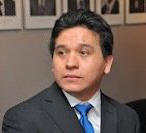 |
Ricardo Rodríguez Jorge, PhD Assistant Professor/Researcher Faculty of Science Department of Informatics Jan Evangelista Purkyně University Czech Republic Mechatronics, Signal Processing, Control and Artificial Neural Networks Research Interest Group |
Visiting Professor, Czech Technical University in Prague, Czech Republic (Dec 2016 -January 2017) Research visit, Tohoku University, Japan (May- Jul 2011) |
Contact Information: E-mail: ricardo.rodriguezjorge.mx@ieee.org Telephone: +420 475 286 724 Office: 6.07 (CPTO) Skype: rodriguezri |
| I welcome my colleagues and fellow academics to this web site. If you would like to discuss any of my published work, please feel free to contact me. My professional interests are mainly in Engineering and my work today has been focused on signal processing and machine learning to bridge innovative ways in these areas. | |||
| I am always looking for industrial and academic collaboration, please do not hesitate to contact me for project collaborations. For more information about my current running projects please visit Research projects. | |||
| Institute web page: https://ki.ujep.cz/cs/personalni-slozeni/ricardo-rodriguez-jorge/ | |||
